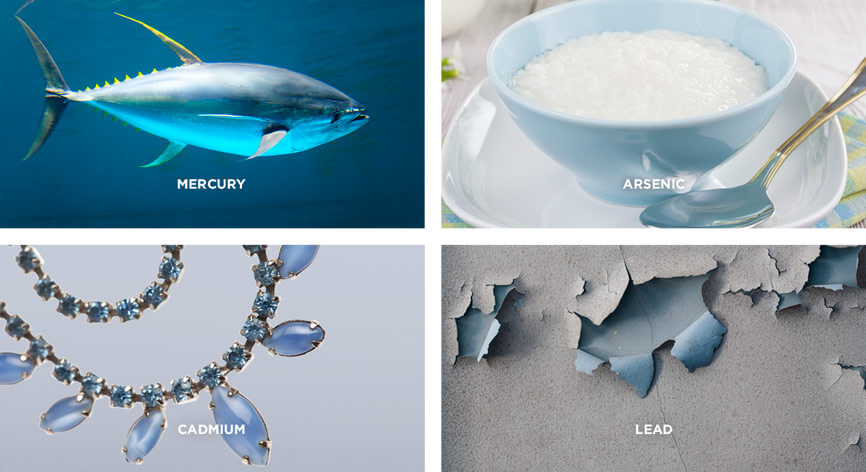Certain Metals
Elemental hazards
What are metals?
Mercury, arsenic, cadmium, and lead are elements that occur naturally in the earth’s crust. Mining and smelting, fossil fuel combustion, industrial processes, and their use in products have led to widespread environmental contamination and human exposure to harmful metals. Learn what you can do.
Mercury is released into air and water by burning coal. The major source of mercury exposure in humans is eating long-lived fish such as shark, swordfish, or albacore tuna. Other sources include some imported face creams, silver-colored dental fillings, older glass thermometers, and fluorescent lights.
Arsenic is often found in foods like rice, mushrooms, apples, and grapes as a result of soil contamination. Rice products (like infant cereal) can have high amounts of inorganic arsenic, which is the more toxic form. Inorganic arsenic is also found in pressure-treated wood used for outdoor structures manufactured before 2004, some drinking water sources, and cigarette smoke.
(Note: Chemists technically classify arsenic as a metalloid, but its environmental behavior and risk of harm is similar to many true metals.)
Cadmium is found in cigarette smoke, metal costume jewelry and charms, rechargeable batteries (labeled NiCd or NiCad), metal plating and solder, and some decorative paints used on glassware and pottery.
Lead exposure is often the result of peeling paint and dust in and around homes built before 1978. Lead can be found in soil contaminated by decades of leaded gasoline use. It can leach into water from plumbing and fixtures that are made of lead or contain lead solder (more common in materials made before 1986). Lead can also be found in improperly made or deteriorating dishware and cookware, toys and costume jewelry, crystal glassware, imported or recycled vinyl products, and some lipsticks.
How are we exposed?
People are exposed to these metals through eating and drinking contaminated food and water, ingesting and inhaling dust, inhaling cigarette smoke, and using certain products. During pregnancy, mercury, arsenic, cadmium, and lead cross the placenta and fetal blood-brain barrier and harm brain development. Infants are further exposed through breastfeeding. Young children typically have higher exposure to metals because they consume more food in relation to their body weight, put their hands and toys in their mouths, and absorb metals more readily than adults. For more information about how you can avoid contact with harmful chemicals, visit our exposure page.
What are the concerns?
Certain metals are often:
PERSISTENT: Do not break down into safer substances in the environment. As they are chemical elements, these metals cannot be broken down, leading to accumulation in ecosystems.
MOBILE: Travel far and are distributed around the world. When released into the air, they can travel long distances before falling on land or surface waters. Because of their persistence and potential for long-range transport, industrial emissions of metals affect even the most remote regions.
BIOACCUMULATIVE: Build up in people and other animals at the top of the food chain. Some forms of metal, such as methylmercury, are more common in the tissues of large predators.
TOXIC: Harmful to humans and ecosystems. Exposure to mercury, arsenic, cadmium, and lead in the womb or in early childhood can harm brain development, leading to learning and behavioral problems. In adults, each metal is associated with increased cancer risk. Mercury and arsenic are associated with adverse effects on the nervous and cardiovascular systems. Cadmium is associated with lung and kidney damage as well as weakened bones. Lead can cause high blood pressure, miscarriages, stillbirth, infertility, and decreased kidney and brain function.
When should they be used?
Despite significant decreases in exposure due to technological improvements and reduced usage in products and industrial processes, these metals continue to pose health and environmental risks. Further phaseouts, abatement programs, emission regulations, cleaner technologies, and proper disposal practices are necessary to reduce metal contamination.
What is being done?
From removing lead from gasoline to the Minamata Convention on Mercury, much progress has been made on metals. However, more work is needed, particularly when it comes to children's exposure.
In 2017 the FDA established a Toxic Elements Working Group to limit lead, arsenic, cadmium, and mercury in food, cosmetics, and dietary supplements. One outcome of this working group is the lowering of the maximum daily intake of lead for children.
Many states are adopting legislation limiting metals in children’s toys, jewelry, and other products.
What can you do?
- Reduce dust exposure by vacuuming, wet-mopping, using door mats, and washing hands.
- Eat a well-balanced diet with adequate calcium, iron, and vitamin C, which can help reduce the amount of lead and cadmium that your body absorbs.
- Properly recycle CFL bulbs, batteries, paint, and electronic waste in the trash (find appropriate recycling facilities here).
To reduce mercury exposure:
- Avoid fish that are high in mercury, such as shark, swordfish, orange roughy, bluefin, and bigeye tuna (see this chart by the U.S. FDA).
- Do not use imported skin lightening, acne treatment, or anti-aging creams unless you are certain that they do not contain mercury.
- Purchase LED light bulbs instead of compact fluorescent light (CFL) bulbs.
- Properly clean up broken thermometers, CFL bulbs, and other items containing mercury (find EPA guidance on cleaning up spills here).
To reduce arsenic exposure:

- To reduce arsenic in your child’s diet, include alternatives to rice-based foods whenever possible.
- Do not use pressure-treated wood manufactured before 2004 which may contain arsenic. Have children wash their hands after they play on or around older wooden play structures or decks. If you own such a structure or deck, apply a sealant or coating every one to two years.
To reduce cadmium exposure:
- Do not let children wear or play with inexpensive metal jewelry or charms.
- Do not let children handle rechargeable batteries labeled NiCd or NiCad.
To reduce lead exposure:
- Renovations, repair jobs and paint jobs in pre-1978 homes and buildings can create significant amounts of lead-based paint dust. In these homes, contractors should be trained in lead-safe practices. Find a Lead-Safe Certified firm here.
- Keep children away from chipped and peeling paint.
- Cover bare soil with grass, bark, or gravel, especially near homes built before 1978.
- Use cold water for drinking or cooking to reduce release of lead from some faucets and old pipes.
Watch our short introductory video on certain metals. Learn about safer products on our Consumer Resources page. Discover how to limit toxic chemicals in your life on our Exposure page.
Videos
Metals: Four-minute introduction to Mercury, Lead, Cadmium, & Arsenic
Dr. Graham Peaslee on Toxic Metals
